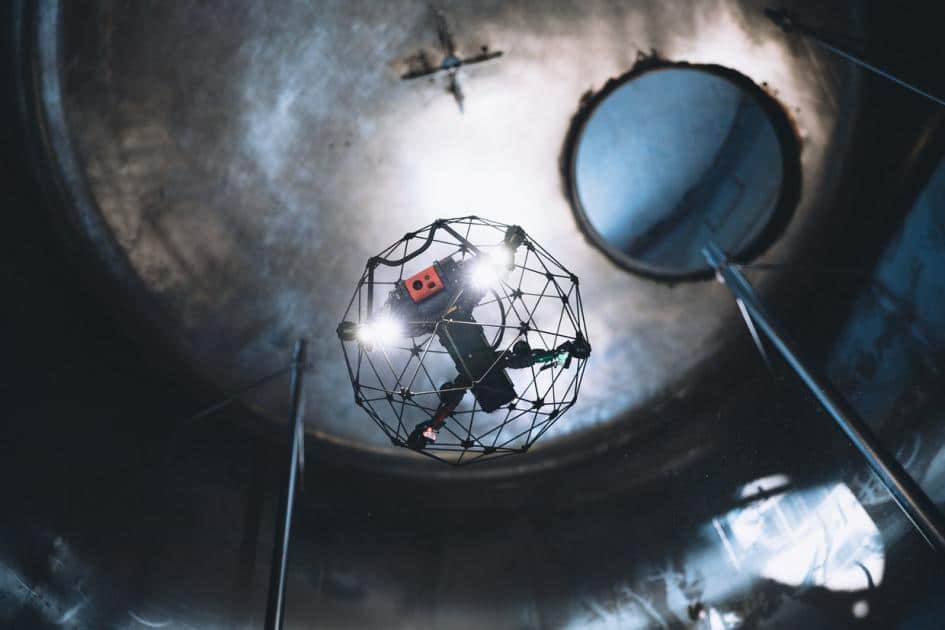INDOOR 3D MODELLING
It’s commonly known that drones are used to create 3D models of structures outdoors. However, what about indoors? This was always a task that seemed to be impossible. That is until now.
The Elios 2 has a rugged design which enables it to fly close to floors, ceilings and walls without the chance of crashing. Because of this ability, the Elios 2 can create extremely accurate, detailed and useful 3D models. Recognising the possibilities, businesses are taking advantage of the Elios 2 to create 3D photogrammetry models of tanks, tunnels and many other assets. In doing so, they can track how an asset changes over time, organise data in a clear and logical way and most importantly plan for preventive maintenance.

Data capture (left) vs 3D model (right)
“The design of the Elios 2 makes it a formidable tool to build 3D models of indoor spaces using photogrammetry”
Why map indoor spaces?
There are many reasons why using 3D photogrammetry technology indoors is beneficial.
Some of the most widely useful examples include:
- Organising data
- Taking measurements
- Tracking changes
- Planning maintenance and design changes
- Training and safety
- Checking the shape and condition of structures (Mining)

ORGANIZING YOUR DATA
Considering the complete workflow for drone-based visual inspection, data acquisition is only a first step. In a second step, the data must be analyzed to extract useful information. With Elios 1 and Elios 2, the pilot can record points of interest (POIs) during the flight and easily find them in the video stream using Inspector, Flyability’s desktop software. However, the pilot may have overlooked some defects or objects of interest, and it is therefore common to carefully review the videos after a series of flights. Also, it is often crucial to understand where the data was acquired, and localize the POIs on blueprints or CAD models. Usually, this is achieved by watching the video again and building a mental map of the asset (keep in mind that indoor datasets do not contain geolocalization information). To determine the position of POIs, it is sometimes required to count repeating elements such as beams, welds, intersections, or other obvious visual features. This method works, but is cumbersome and not really scaleable.
In some situations, 3D modeling can drastically simplify this tedious and time-consuming task. With a 3D model and the trajectory of the drone, it is much easier to navigate in the dataset, to review only the relevant images and to understand the location of the POIs. The risk of errors – such as confusing repeating elements – decreases and the overall understanding of the asset geometry becomes clearer.

MAKING MEASUREMENTS
Visual information is often the starting point of all type of inspection, but being able to put a number on visual features is often crucial to help the decision-making process. By focusing data capture efforts on a small part of an asset, it is possible to build a local 3D model that offers great details and accuracy. For example, Elios 2 takes images with a Ground Sampling Distance (GSD) down to 0.18 mm/px (0.007 in/px) when capturing data at a 30 cm (11.8 in) distance. This resolution offers great perspectives for photogrammetry software, such as Pix4D Mapper, to build very precise 3D models.
As Alex Buczkowski reminds us in his blog post “How accurate is your drone survey?”, it is very important to include objects with known dimensions in the model. This allows to scale the model accurately, even without ground control points. It is then possible to measure objects or defects on the original images, and to visualize them in the 3D model.

CHECKING THE SHAPE AND CONDITION OF STRUCTURES – THE CASE FOR MINING
This application is very specific and it deserves its place here as it will certainly inspire other industries with similar problems. Underground mining consists mainly in excavating large volumes of ore from the entrails of the earth to then extract various minerals through chemical refining processes, for instance. The excavation leaves large openings called stopes. These stopes are extremely dangerous areas, where no humans are allowed.
After blasting the ore body, the ore is extracted from the bottom, in a similar fashion to a cereal dispenser. Geotechnical engineers are in charge of ensuring the underground workings – such as stopes, galleries, shafts, and raises – are stable and they don’t fall down on the miners. To complete their tasks, geotechnical engineers need to understand the shape (3D model) and condition (visual information) of these workings. Photogrammetry successfully combines 3D model reconstruction with visual information and solves many of their problems. 3D models of stopes give access to a whole new level of information about these areas where the risk of being smashed by rocks the size of a car is not negligible.

TRACKING CHANGES
The classic example of asset management is of course tracking how the conditions of an asset, and more particularly defects, evolve over time. This allows the planning of preventive maintenance and repairs before any defect becomes an actual threat to the asset operation. This is something that doesn’t necessarily require to make a full new digital twin of the asset in outdoor use cases, since GPS and orientation information can be sufficient to know where to retake a picture. For the indoor use case, or more generally GPS-denied environments, making a 3D model is the only option as the drone doesn’t have localization information while it’s flying.
PLANNING MAINTENANCE AND DESIGN CHANGES
Digital twins are not only useful to track defects over time and decide when it’s time to tackle them. They are also helpful in the planning phase of maintenance and design changes. The digital twin allows to plan where to put scaffolding, and how the area should be accessed. When a large new piece of equipment needs to be moved through a plant, a traversability analysis can be performed to find the optimal route. For design changes as well, it is indispensable to have an up-to-date 3D model to design and visualize the new changes.

TRAINING AND SAFETY
Complex and dangerous assets often require extensive training of new personnel on the layout of the factory, before they can take part in operations. A classic example here is nuclear industry. To plan escape routes in case of emergency situations they need up to date floor plans in all parts of the asset. Here again a digital twin of the asset proves to be helpful. In such application the photogrammetry model is often annotated with loads of additional information about the asset.
The information above was taken from Flyability.

CHANGING THE GAME
“Drones can reach what was once inaccessible to the human eye and create accurate 3D models”
SUMMARY
The features added to Elios 2 ensures a more stable, accurate, and improved model to capture pictures in more difficult environments with obstructions that make inspection more tedious. This allows the task being done to be not only accurate, but also easier to collect data from.
Photogrammetry is an important method in analyzing and capturing images, whether doing so in an outdoor or indoor environment, but being able to do this with the simplicity of a drone like Elios 2 makes the task.















